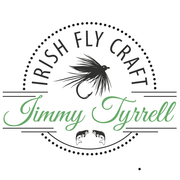Tyrrell's Golden Olive Mayfly - Irish Angler Magazine July 2012
- by James Tyrrell
-

Jimmy Tyrrell knows a good fly when he sees one, so when someone sent him this mayfly pattern to tie, he decided to keep a few for himself. See what you think.
There are a lot of very nice wet mayfly patterns out there and some really beautiful creations. When I look back at some the old Rogan’s patterns they were truly works of art with all the different shades of olive and dyed partridge hackles. They’ve all stood the test of time and are still being used to this day, even though there are so many different patterns out there with all the different materials that can be obtained and there are new creations popping up all the time.
Everyone has their favourite pattern. Over the years I’ve seen hundreds of different mayfly patterns and they have probably all caught fish at some time or another. That’s the beauty of mayfly imitations: they will all work at one time or another.
This is another pattern that I had not seen until recently. It’s a wet mayfly pattern that was given to me to tie up for fishing the western loughs. I don’t know the name of it, so I called it what I think it is, which is Golden Olive.
When I first saw the fly I thought this is a pattern that would surely entice a trout into taking it. I had to tie up a few for myself to try out, as it looked like a fly that would catch a fish or two on the day in the right conditions and light. It’s very bright mayfly pattern, with a nice green fluorescent butt just above the tail fibres. I’ve just added a grey partridge hackle dyed olive to give the fly a bit more movement in the water. I think it just gives the fly a nice life-like pulse when it’s being stripped back.
"When the light catches it at different angles and the colours change as the fly moves through the water it adds another dimension to the fly."
There is a little bit of tying in this pattern, but I think it’s well worth the effort as it is a really nice creation. Hopefully someone might tell me something about it when they see the fly in the article.
I firmly believe that it’s important to use good quality hackles in your fly patterns if you can obtain them. Genetic capes are quite easy to obtain now and have come down in price compared to what they were some years ago and there is a huge selection of different shades to be had. I have some really nice ones that were dyed in picric for me by Lawrence Finney. Also, if the hackle has a nice sheen to it this gives it a little bit more. When the light catches it at different angles and the colours change as the fly moves through the water it adds another dimension to the fly and gives it a bit more life in the water which should attract more trout to it.
The body material is important in these type of patterns and seal’s fur is definitely a favourite of mine for most mayfly patterns. I like to just dub enough seal’s fur on to the tying silk so that the orange shows through. This also makes the body nice and slim with not too much bulk.
There’s a lot of hackle on these patterns so it’s important not to overdo it. You want the fly to have movement in the water and too much hackle has the opposite effect. I hope this pattern turns out to be one that catches its share of fish as it is a very nice creation.
Tyrrell's Golden Olive May
| Hook: | Size 10 Kamasan B170 |
| Tying Silk: | Orange |
| Tail: | Cock pheasant tail fibres and fluorescent green floss |
| Rib: | Gold oval |
| Body: | Yellow seal’s fur |
| Body Hackle: | Yellow cock |
| Hackle: | Dyed olive or yellow grey partridge hackle |
| Front Hackle: | Golden olive French partridge hackle |
Tying Instructions
 Step One:
Tie in a few fibres of cock pheasant tail for the tail.
Step One:
Tie in a few fibres of cock pheasant tail for the tail.
 Step Two: Tie in the floss just over the tail feathers.
Step Two: Tie in the floss just over the tail feathers. Step Three: Catch in the rib.
Step Three: Catch in the rib. Step Four: Dub on some seal’s fur and wind on for the body.
Step Four: Dub on some seal’s fur and wind on for the body. Step Five: Tie in the body hackle, wind it back down and hold it in place with the rib.
Step Five: Tie in the body hackle, wind it back down and hold it in place with the rib. Step Six: Catch in the partridge hackle.
Step Six: Catch in the partridge hackle. Step Seven: Make about two turns and tie off.
Step Seven: Make about two turns and tie off. Step Eight: Tie in the French partridge hackle.
Step Eight: Tie in the French partridge hackle. Step Nine: Make two and a half turns and tie off. Whip finish and varnish.
Step Nine: Make two and a half turns and tie off. Whip finish and varnish.Tying Tips
Tip 1: Dub the seal’s fur on sparsely so that the orange thread shows through.
TIP 2: Make sure to leave plenty of room behind the eye when winding up the body as there are three different hackles to tie in.
TIP 3: Don’t make too many turns of the head hackle. Two to three is plenty.





